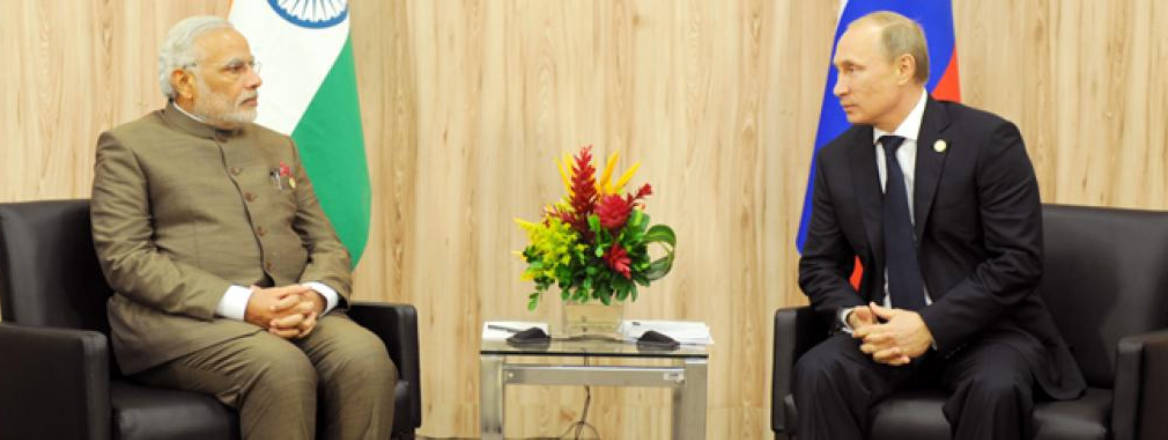Ties between India and Russia may not be strengthening quite so fast as both sides diversify their partners, but history and strategic considerations still bind the two powers.
The joint statement released during Russian President Vladimir Putin’s visit to India last month emphasised Moscow and New Delhi’s ‘Special and Privileged Strategic Partnership’. This phrase has also been used previously by Indian and Russian leaders; however, both have broadened their strategic horizons in recent years. While neither was heavily dependent on the other for their economic interests, both states appear to be drifting apart even in terms of arms sales, which has been the lynchpin of their bilateral relationship.
This shift is particularly visible in India’s increasing defence and security cooperation with the US, as it seeks to steadily move away from its long-espoused stance of ‘non-alignment’ and diversify its defence imports. Between 2013 and 2017, Russia provided 62% of India’s total arms imports – down from 79% between 2008 and 2012. Over the same periods, the US increased its arms exports to India five-fold, and grew to become India’s second-largest supplier, accounting for 15% of its total arms imports between 2013 and 2017. The evolving India-US relationship is part of a longer-term strategic realignment, which is motivated in part by China’s expanding role in the Indian Ocean and the emergence of a constellation of international actors seeking to balance this influence, a process in which it is difficult to see Russia playing a significant role.
India’s diversification has also been influenced by hardware- and delivery-related obstacles with Russian equipment. India withdrew from an 11-year collaborative project with Russia to build a fifth-generation fighter aircraft ‘following enduring differences over its developmental cost and technological capabilities’. This has not been a wholly uncommon problem. Similar difficulties were faced during the refurbishment of the INS Vikramaditya aircraft carrier, which faced repeated delays and bloated costs. Further, in 2016, the Comptroller and Auditor General of India reported that the MiG-29K/KUB aircraft used by the Indian Navy experienced problems with its airframe and engine, which affected serviceability rates and flight safety.
On the other hand, the continuing importance of India in Russia’s defence exports is highlighted by the fact that India accounted for 35% of Russia’s total arms exports from 2008 to 2017. Nevertheless, Russia has started exploring a deeper military relationship with India’s neighbour, Pakistan, signing an agreement that enables the training of Pakistani troops at Russian institutions and engaging in joint military drills. However, given the magnitude of Russian exports to India, it remains to be seen to what extent Russia will allow its budding Pakistan link to develop. It is also notable that these developments in Russia-Pakistan relations coincide with tensions in the latter’s ties with the US, leading to cuts in US military assistance as well as training programmes.
In spite of these shifts, it is unlikely that India and Russia will disentangle their defence relationship beyond a certain point. While India may be looking to hedge its relationships and ‘overcome the hesitations of history’ in its relationship with the US, Russia remains a crucial partner. Russia has delivered equipment that Western partners may be more hesitant to provide. INS Arihant, India’s nuclear submarine and the final piece of its nuclear triad, is based on Russia’s Akula-1-class submarines and was built in India with assistance from Russian scientists. Discussions are currently underway to expand this programme to include joint design and construction for the next generation of India’s nuclear submarines. In addition, India’s space programme has benefited from Russian assistance for several decades, and it continues to do so as India prepares to launch its first crewed space mission.
Russia has been a steadfast supplier of arms to India since the 1960s, and therefore a large portion of India’s existing military equipment is of Russian origin. Consequently, a strong relationship helps to ensure a steady supply of spares and components. The close ties have also led to the development of trust among key civilian and military stakeholders in India, which does not yet exist between New Delhi and Washington. The numerous highs and lows of the India-US relationship mean that there is some scepticism about the reliability of the US as a defence equipment supplier. This is compounded by concerns that the US can leverage its security relationship in order to achieve political objectives, like it appears to be doing at the moment in its relationship with Pakistan.
This was most recently manifested in the Countering America's Adversaries Through Sanctions Act (CAATSA), which targets ‘significant transactions’ with entities in the defence or intelligence sectors of Russia and covers a number of US partners, including India. Apprehensions about further US pressure, along with India’s critical need for defence equipment and modernisation, is why India was willing to risk the prospect of indirect US sanctions and sign an agreement worth $5.4 billion for the supply of Russia’s S-400 Triumf air defence missile system during President Putin’s visit. Indeed, in what might be viewed as reinforcing India’s concerns about the US, reports suggest that the US has offered to provide a CAATSA waiver in exchange for India’s purchase of F-16 fighter aircraft.
Even beyond hardware considerations, however, there is a strategic imperative for both India and Russia to sustain a strong bilateral relationship. For India, this provides the foundation for an increased focus on energy, particularly liquified natural gas and nuclear reactors. It also represents a close link with a permanent member of the UN Security Council (UNSC) and one that has expressed its support for India’s accession to both the UNSC and the Nuclear Suppliers Group. For both India and Russia, the sizeable defence equipment portfolio ensures that there is sufficient stake in the relationship to prevent a lurch towards the US by India or towards China by Russia.
Thus, while India has reduced its dependence on Russian equipment and has become closer to the US, particularly in the Indian Ocean region, the legacy of its deep relations with Russia cannot be ignored. Both for practical considerations related to the maintenance and modernisation of its military as well as to exercise its ‘strategic autonomy’, India is likely to continue its military engagement with Russia.
Simultaneously, India has become more open to expanding its security cooperation with the US, as evidenced by its signing of the Communications Compatibility and Security Agreement, commonly known by its acronym COMCASA, with the US in September. Even though this may be seen as contradictory in Washington and could cause tension with a White House which tends to view relations with other countries in a binary fashion, India is unlikely to pick sides as it continues to balance its great power relationships.
Aaditya Dave is a Research Analyst in the International Security Studies team at RUSI.
The views expressed in this Commentary are the author’s, and do not necessarily reflect those of RUSI or any other institution.
WRITTEN BY
Aaditya Dave
Former Research Analyst, South Asia


